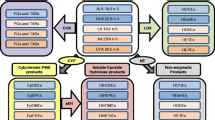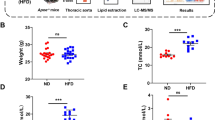Abstract
Oxidized low-density lipoprotein (OxLDL) plays an important role in initiation and progression of atherosclerosis. Proatherogenic effects of OxLDL have been attributed to bioactive phospholipids generated during LDL oxidation. It is unknown what effect oxidation has on the phosphatidylinositol (PtdIns) molecules in LDL, even though PtdIns is 6% of the total LDL phospholipid pool. We sought to identify and quantitate oxidized phosphatidylinositol (OxPtdIns) species in OxLDL and human atherosclerotic plaque. Bovine liver PtdIns was subjected to non-enzymatic and lipoxygenase-catalyzed oxidation. Reversed-phase liquid chromatography with negative ESI–MS identified and confirmed compounds by fragmentation pattern analysis from which an OxPtdIns library was generated. Twenty-three OxPtdIns molecules were identified in copper-oxidized human LDL at 0, 6, 12, 24, 30, and 48 h, and in human atherosclerotic plaque. In OxLDL, OxPtdIns species containing aldehydes and carboxylates comprised 17.3 ± 0.1 and 0.9 ± 0.2%, respectively, of total OxPtdIns in OxLDL at 48 h. Hydroperoxides and isoprostanes at 24 h (68.5 ± 0.2 and 22.8 ± 0.2%) were significantly greater than 12 h (P < 0.01) without additional changes thereafter. Hydroxides decreased with increased oxidation achieving a minimum at 24 h (5.2 ± 0.3%). Human atherosclerotic plaques contained OxPtdIns species including aldehydes, carboxylates, hydroxides, hydroperoxides and isoprostanes, comprising 18.6 ± 4.7, 1.5 ± 0.7, 16.5 ± 7.4, 33.3 ± 1.1 and 30.2 ± 3.3% of total OxPtdIns compounds. This is the first identification of OxPtdIns molecules in human OxLDL and atherosclerotic plaque. With these novel molecules identified we can now investigate their potential role in atherosclerosis.









Similar content being viewed by others
Abbreviations
- CM:
-
2:1 Chloroform:methanol
- BHT:
-
Butylated hydroxytoluene
- EDTA:
-
Ethylenediaminetetraacetic acid
- EPD:
-
Embolic protection device
- IL:
-
Interleukin
- I/R:
-
Ischemia/reperfusion
- KDdiA-PtdCho:
-
1-Palmitoyl-2-(4-keto-dodec-3-ene-dioyl)-phosphatidylcholine
- LGE2:
-
Levuglandin E2
- LOX-I:
-
Lipoxygenase-I
- Lp-PLA2:
-
Lipoprotein-associated phospholipase A2
- MRM:
-
Multiple reaction monitoring
- NP:
-
Normal-phase
- OxLDL:
-
Oxidized low density lipoprotein
- OxPtdCho:
-
Oxidized phosphocholine
- OxPtdIns:
-
Oxidized phosphatidylinositol
- PAF:
-
Platelet-activating factor
- PAPtdCho:
-
1-Palmitoyl-2-arachidonoyl-sn-glycero-3-phosphocholine
- PCI:
-
Percutaneous coronary intervention
- PDHPtdCho:
-
1-Palmitoyl-2-docosahexaenoyl-sn-glycero-3-phosphocholine
- PEI:
-
1-Palmitoyl-2-epoxyisoprostane
- PGPtdCho:
-
1-Palmitoyl-2-glutaryl-sn-glycero-3-phosphocholine
- PtdIns:
-
Phosphatidylinositol
- PtdIns-4-P:
-
Phosphatidylinositol 4-phosphate
- PtdIns-4,5-P2 :
-
Phosphatidylinositol 4,5-bisphosphate
- PtdIns-3,4,5-P3 :
-
Phosphatidylinositol 3,4,5-trisphosphate
- PtdIns 3K:
-
Phosphoinositide 3-kinases
- PKB:
-
Protein kinase B
- PLPtdCho:
-
1-Palmitoyl-2-linoleoyl-sn-glycero-3-phosphocholine
- PONPtdCho:
-
1-Palmitoyl-2-(9-oxo)nonanoyl-sn-glycero-3-phosphocholine
- POVPtdCho:
-
1-Palmitoyl-2-(5-oxo-valeroyl)-sn-glycero-3-phosphocholine
- ROS:
-
Reactive oxygen species
- RP:
-
Reversed-phase
- SAPtdCho:
-
1-Stearoyl-2-arachidonoyl-sn-glycero-3-phosphocholine
- SEC:
-
1-Stearoyl-epoxycholine
- SEI:
-
1-Stearoyl-epoxyisoprostane
- SLPtdCho:
-
1-Stearoyl-2-linoleoyl-sn-glycero-3-phosphocholine
- SVG:
-
Saphenous vein graft
- TIC:
-
Total ion chromatogram
- TNFα:
-
Tumor necrosis factor alpha
References
Hartvigsen K, Chou M-Y, Hansen L, Shaw P, Tsimikas S, Binder C, Witztum J (2009) The role of innate immunity in atherogenesis. J Lipid Res 50 Suppl:S388–S393
Steinberg D, Witztum J (2010) Oxidized low-density lipoprotein and atherosclerosis. Arterioscler Thromb Vasc Biol 30:2311–2316
Levitan I, Volkov S, Subbaiah PV (2010) Oxidized LDL: diversity, patterns of recognition, and pathophysiology. Antioxid Redox Signal 13:39–75
Stemmer U, Dunai Z, Koller D, Pürstinger G, Zenzmaier E, Deigner H, Aflaki E, Kratky D, Hermetter A (2012) Toxicity of oxidized phospholipids in cultured macrophages. Lipids Health Dis 11:110
Pégorier S, Stengel D, Durand H, Croset M, Ninio E (2006) Oxidized phospholipid: POVPC binds to platelet-activating-factor receptor on human macrophages: implications in atherosclerosis. Atherosclerosis 188:433–443
Fruhwirth G, Moumtzi A, Loidl A, Ingolic E, Hermetter A (2006) The oxidized phospholipids POVPC and PGPC inhibit growth and induce apoptosis in vascular smooth muscle cells. Biochim Biophys Acta 1761:1060–1069
van Dijk R, Kolodgie F, Ravandi A, Leibundgut G, Hu P, Prasad A, Mahmud E, Dennis E, Curtiss L, Witztum J, Wasserman B, Otsuka F, Virmani R, Tsimikas S (2012) Differential expression of oxidation-specific epitopes and apolipoprotein(a) in progressing and ruptured human coronary and carotid atherosclerotic lesions. J Lipid Res 53:2773–2790
Skipski VP, Barclay M, Barclay RK, Fetzer VA, Good JJ, Archibald FM (1967) Lipid composition of human serum lipoproteins. Biochem J 1967:340–352
Fruman DA, Meyers RE, Cantley LC (1997) Phosphoinositide kinases. Annu Rev Biochem 67:481–507
Cantrell DA (2001) Phosphoinositide 3-kinase signalling pathways. J Cell Sci 114:1439–1445
Kane LP, Weiss A (2003) The PI-3 kinase/Akt pathway and T cell activation: pleiotropic pathways downstream of PIP3. Immunol Rev 192:7–20
Balla T (2013) Phosphoinositides: tiny lipids with giant impact on cell regulation. Physiol Rev 93:1019–1137
Ravandi A, Babaei S, Leung R, Monge J, Hoppe G, Hoff H, Kamido H, Kuksis A (2004) Phospholipids and oxophospholipids in atherosclerotic plaques at different stages of plaque development. Lipids 39:97–109
Thomas C, Morgan L, Maskrey B, Murphy R, Kühn H, Hazen S, Goodall A, Hamali H, Collins P, O’Donnell V (2010) Phospholipid-esterified eicosanoids are generated in agonist-activated human platelets and enhance tissue factor-dependent thrombin generation. J Biol Chem 285:6891–6903
Kamido H, Eguchi H, Ikeda H, Imaizumi T, Yamana K, Hartvigsen K, Ravandi A, Kuksis A (2002) Core aldehydes of alkyl glycerophosphocholines in atheroma induce platelet aggregation and inhibit endothelium-dependent arterial relaxation. J Lipid Res 43:158–166
Bochkov V, Oskolkova O, Birukov K, Levonen A-L, Binder C, Stöckl J (2010) Generation and biological activities of oxidized phospholipids. Antioxid Redox Signal 12:1009–1059
Nakanishi H, Iida Y, Shimizu T, Taguchi R (2009) Analysis of oxidized phosphatidylcholines as markers for oxidative stress, using multiple reaction monitoring with theoretically expanded data sets with reversed-phase liquid chromatography/tandem mass spectrometry. J Chromatogr B Anal Technol Biomed Life Sci 877:1366–1374
Ibusuki D, Nakagawa K, Asai A, Oikawa S, Masuda Y, Suzuki T, Miyazawa T (2008) Preparation of pure lipid hydroperoxides. J Lipid Res 49:2668–2677
Folch J, Lees M, Sloane Stanley G (1957) A simple method for the isolation and purification of total lipides from animal tissues. J Biol Chem 226:497–509
Gruber F, Bicker W, Oskolkova O, Tschachler E, Bochkov V (2012) A simplified procedure for semi-targeted lipidomic analysis of oxidized phosphatidylcholines induced by UVA irradiation. J Lipid Res 53:1232–1242
Ravandi A, Leibundgut G, Hung M-Y, Patel M, Hutchins PM, Murphy RC, Prasad A, Mahmud E, Miller YI, Dennis EA, Witztum JL, Tsimikas S (2014) Release and capture of bioactive oxidized phospholipids and oxidized cholesteryl esters during percutaneous coronary and peripheral arterial interventions in humans. J Am Coll Cardiol 63:1961–1971
White CW, Hasanally D, Mundt P, Li Y, Xiang B, Klein J, Muller A, Ambrose E, Ravandi A, Arora RC, Lee TW, Hryshko LV, Large S, Tian G, Freed DH (2015) A whole blood-based perfusate provides superior preservation of myocardial function during ex vivo heart perfusion. J Heart Lung Transplant 34:113–121
Zeglinski M, Premecz S, Lerner J, Wtorek P, daSilva M, Hasanally D, Chaudhary R, Sharma A, Thliveris J, Ravandi A, Singal PK, Jassal DS (2014) Congenital absence of nitric oxide synthase 3 potentiates cardiac dysfunction and reduces survival in doxorubicin- and trastuzumab-mediated cardiomyopathy. Can J Cardiol 30:359–367
Breckenridge WC, Palmer FB (1982) Fatty acid composition of human plasma lipoprotein phosphatidylinositols. Biochim Biophys Acta 712:707–711
Yin H, Cox BE, Liu W, Porter NA, Morrow JD, Milne GL (2009) Identification of intact oxidation products of glycerophospholipids in vitro and in vivo using negative ion electrospray ion trap mass spectrometry. J Mass Spectrom 44:672–680
Ravandi A, Kuksis A, Shaikh N, Jackowski G (1997) Preparation of Schiff base adducts of phosphatidylcholine core aldehydes and aminophospholipids, amino acids, and myoglobin. Lipids 32:989–1001
Bordun KA, Premecz S, daSilva M, Mandal S, Goyal V, Glavinovic T, Cheung M, Cheung D, White CW, Chaudhary R, Freed DH, Villarraga HR, Herrmann J, Kohli M, Ravandi A, Thliveris J, Pitz M, Singal PK, Mulvagh S, Jassal DS (2015) The utility of cardiac biomarkers and echocardiography for the early detection of bevacizumab- and sunitinib-mediated cardiotoxicity. Am J Physiol Heart Circ Physiol 309:H692–H701
White C, Ali A, Hasanally D, Xiang B, Li Y, Mundt P, Lytwyn M, Colah S, Klein J, Ravandi A, Arora R, Lee T, Hryshko L, Large S, Tian G, Freed D (2013) A cardioprotective preservation strategy employing ex vivo heart perfusion facilitates successful transplant of donor hearts after cardiocirculatory death. J Heart Lung Transplant 32:734–743
Kimura T, Shibata Y, Yamauchi K, Igarashi A, Inoue S, Abe S, Fujita K, Uosaki Y, Kubota I (2012) Oxidized phospholipid, 1-palmitoyl-2-(9′-oxo-nonanoyl)-glycerophosphocholine (PON-GPC), produced in the lung due to cigarette smoking, impairs immune function in macrophages. Lung 190:169–182
Chen R, Yang L, McIntyre T (2007) Cytotoxic phospholipid oxidation products. Cell death from mitochondrial damage and the intrinsic caspase cascade. J Biol Chem 282:24842–24850
Springstead J, Gugiu B, Lee S, Cha S, Watson A, Berliner J (2012) Evidence for the importance of OxPAPC interaction with cysteines in regulating endothelial cell function. J Lipid Res 53:1304–1315
Delerive P, Furman C, Teissier E, Fruchart J, Duriez P, Staels B (2000) Oxidized phospholipids activate PPARα in a phospholipase A2-dependent manner. FEBS Lett 471:34–38
Fruhwirth G, Loidl A, Hermetter A (2007) Oxidized phospholipids: from molecular properties to disease. Biochim Biophys Acta 1772:718–736
Birukova A, Starosta V, Tian X, Higginbotham K, Koroniak L, Berliner J, Birukov K (2013) Fragmented oxidation products define barrier disruptive endothelial cell response to OxPAPC. Transl Res 161:495–504
Koivusalo M, Haimi P, Heikinheimo L, Kostiainen R, Somerharju P (2001) Quantitative determination of phospholipid compositions by ESI-MS: effects of acyl chain length, unsaturation, and lipid concentration on instrument response. J Lipid Res 42:663–672
Acknowledgments
This research was supported by operating grants from the Heart and Stroke foundation of Canada and Research Manitoba. DH was a recipient of a Research Manitoba graduate scholarship.
Author information
Authors and Affiliations
Corresponding author
Ethics declarations
Conflict of interest
The authors declare no conflicts of interest.
Electronic supplementary material
Below is the link to the electronic supplementary material.
About this article
Cite this article
Hasanally, D., Edel, A., Chaudhary, R. et al. Identification of Oxidized Phosphatidylinositols Present in OxLDL and Human Atherosclerotic Plaque. Lipids 52, 11–26 (2017). https://doi.org/10.1007/s11745-016-4217-y
Received:
Accepted:
Published:
Issue Date:
DOI: https://doi.org/10.1007/s11745-016-4217-y




